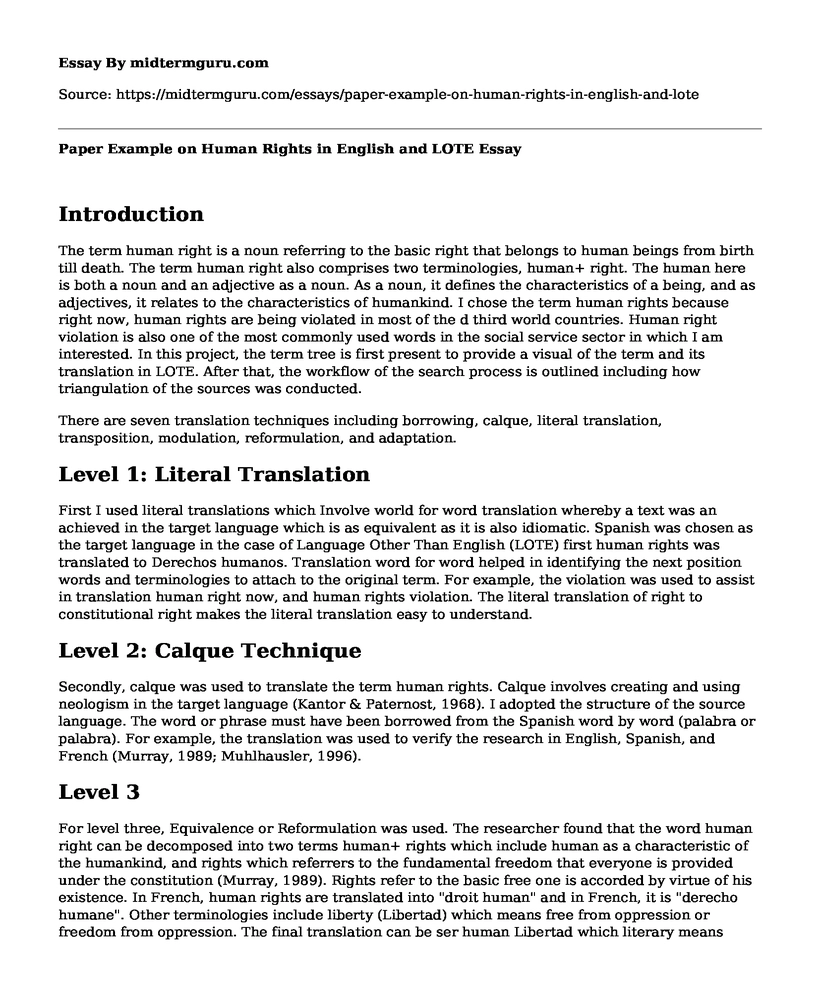Introduction
The term human right is a noun referring to the basic right that belongs to human beings from birth till death. The term human right also comprises two terminologies, human+ right. The human here is both a noun and an adjective as a noun. As a noun, it defines the characteristics of a being, and as adjectives, it relates to the characteristics of humankind. I chose the term human rights because right now, human rights are being violated in most of the d third world countries. Human right violation is also one of the most commonly used words in the social service sector in which I am interested. In this project, the term tree is first present to provide a visual of the term and its translation in LOTE. After that, the workflow of the search process is outlined including how triangulation of the sources was conducted.
There are seven translation techniques including borrowing, calque, literal translation, transposition, modulation, reformulation, and adaptation.
Level 1: Literal Translation
First I used literal translations which Involve world for word translation whereby a text was an achieved in the target language which is as equivalent as it is also idiomatic. Spanish was chosen as the target language in the case of Language Other Than English (LOTE) first human rights was translated to Derechos humanos. Translation word for word helped in identifying the next position words and terminologies to attach to the original term. For example, the violation was used to assist in translation human right now, and human rights violation. The literal translation of right to constitutional right makes the literal translation easy to understand.
Level 2: Calque Technique
Secondly, calque was used to translate the term human rights. Calque involves creating and using neologism in the target language (Kantor & Paternost, 1968). I adopted the structure of the source language. The word or phrase must have been borrowed from the Spanish word by word (palabra or palabra). For example, the translation was used to verify the research in English, Spanish, and French (Murray, 1989; Muhlhausler, 1996).
Level 3
For level three, Equivalence or Reformulation was used. The researcher found that the word human right can be decomposed into two terms human+ rights which include human as a characteristic of the humankind, and rights which referrers to the fundamental freedom that everyone is provided under the constitution (Murray, 1989). Rights refer to the basic free one is accorded by virtue of his existence. In French, human rights are translated into "droit human" and in French, it is "derecho humane". Other terminologies include liberty (Libertad) which means free from oppression or freedom from oppression. The final translation can be ser human Libertad which literary means human freedom/ or human liberty
Triangulation
To verify the correct terminology, a number of sources were used including the Oxford dictionary, encyclopedia, and the internet. Using the internet and dictionary, the researcher found that Paronymous calque or loan word was more effective in the translation as there was an incorrect correspondence between the words despite their different etymologies (Phillipson, 1998). Human rights have evolved so much that it has a completely different meaning. I relied on the sole language of human rights to have a starting point when the alphabets are different. Human rights were changed by Eleanor Roosevelt when e suggested the "rights of human" should be changed to "human right ". The term was originally created by Thomas Paine when he translated the French declaration of the right of man and citizens. I used the first three references (or sources) for triangulation. Then I used the internet websites for the linguistic glossary to find insight into the terminology. After creating the terminology tree in English, I copied the template for the figure to complete the terminology in (LOTE) Spanish to categories the term "human rights" across three levels.
References
Eminov, A. (2001). Linguistic Genocide in Education--or Worldwide Diversity and Human Rights (review). Language, 77(2), 421-422. doi: 10.1353/lan.2001.0079
Hornberger, N. (1998). Linguistic Human Rights: Overcoming Linguistic Discrimination. Tove Skutnabb-Kangas, Robert Phillipson, Mart Rannut. International Journal Of American Linguistics, 64(2), 174-176. doi: 10.1086/466356
Kantor, M., & Paternost, J. (1968). Russian-English Glossary of Linguistic Terms. The Modern Language Journal, 52(5), 315. doi: 10.2307/322890
Muhlhausler, P. (1996). Linguistic human rights: Overcoming linguistic discrimination. Lingua, 99(4), 257-260. doi: 10.1016/0024-3841(96)84200-8
Murray, T. (1989). The language of sadomasochism: a glossary and linguistic analysis. Choice Reviews Online, 26(11), 26-6025-26-6025. doi: 10.5860/choice.26-6025
Phillipson, R. (1998). Globalizing English: Are linguistic human rights an alternative to linguistic imperialism?. Language Sciences, 20(1), 101-112. doi: 10.1016/s0388-0001(97)00015-6
Cite this page
Paper Example on Human Rights in English and LOTE. (2022, Sep 13). Retrieved from https://midtermguru.com/essays/paper-example-on-human-rights-in-english-and-lote
If you are the original author of this essay and no longer wish to have it published on the midtermguru.com website, please click below to request its removal:
- Summary of Case 66C: Alvin Bruce and Square One Inc
- Introduction to Criminal Justice Essay Sample
- Paper Example on Gun Control and Ownership
- Why Some Hackers Are Successful in Phishing - Paper Example
- Discrimination in the US: A Historical Persistence Since Founding - Essay Sample
- Research Paper on African Americans and the Criminal Justice System
- Criminal Justice: Plead Guilty Or Take the Risk? - Essay Sample







